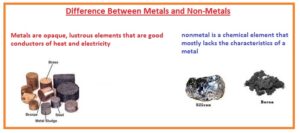 Hello guys, I hope you all are doing great. In today’s tutorial, we will discuss Difference Between Metals and Non-Metals. Metallic and non-metallic are different with each other due to change in some physical and chemical features. non-metallic substances are soft in nature due to weak atomic bonds. Metallic substances are hard in nature due to the existence of a strong metallic bond among the atoms. Metal is a material through which current can passes. They are coming to make different sheets after the application of force. metals are chemical material like iron alloy
Hello guys, I hope you all are doing great. In today’s tutorial, we will discuss Difference Between Metals and Non-Metals. Metallic and non-metallic are different with each other due to change in some physical and chemical features. non-metallic substances are soft in nature due to weak atomic bonds. Metallic substances are hard in nature due to the existence of a strong metallic bond among the atoms. Metal is a material through which current can passes. They are coming to make different sheets after the application of force. metals are chemical material like iron alloy
. In today’s post, we will discuss different features and parameters of both metals and non-metals substances and compare them to find their differences. So let’s get started with the Difference Between Metals and Non-Metals.
Difference Between Metals and Non-Metals
Metals
- Such substances that has one to three number of electrons in the outermost shell are called metals except for hydrogen.
- Metals except mercury and gallium exist in solid form.
- Their density is high.
- Metals formed cations.
- Metallic elements are good conductors and current can pass through them easily.
- Their tensile strength is high.
- Their melting and boiling point is large.
- The present in the periodic table on the left side.
- A metallic bond exists between metals.
- Metals are malleable and ductile in nature.
- Their structure is hard.
- After reaction with the oxygen metals form basic oxides.
- After reaction with the acids creates hydrogen.
Examples of Metals
- The commonly found metals are iron, gold, Copper Aluminum, lead-silver, etc.
Wha is Alloy
- Alloy is a substance that shows the properties of metal and created through the use of 2 or more 2 metallic substances. Their physical structure can have fixed or changeable structures
- the alloy created through the use of gold and silver has a changeable quantity of gold according to the structure.
- The pure shape of the metallic substance is soft brittle and takes part in different reactions.
- The features and parameters of alloy can be changes through the use of different quantity sof metallics according to requirements
- The main benefit of these substances is that they are less resistant and less effective through corrosion so it mostly employed.
Non-Metals
- Such substances that have four to seven electrons in the valence shell are called non-metals.
- The conductive behavior is less or current can not flow through them.
- Their tensile strength is less.
- Their melting point is less than the metals.
- Metals present at the right side of the periodic table.
- After reaction with the oxygen, they create acidic oxides.
- Their nature is electronegative.
- A covalent bond is present between the nonmetals atoms.
- Their physical state can be solid, gases and liquid.
- Their density is less.
- Non-metals create anions.
- Their nature as compared to metals is non-malleable and non-ductile.
- Their structure is soft compare to the metals.
- Non metals do not show a reaction with the acids.
Examples Non Metals
- Examples of non-metals are oxygen, carbon, sulphur, iodine, etc.
That is a detailed post about difference between metals and non-metals if you have any query ask in comments. Thanks for reading. Have a good day.







